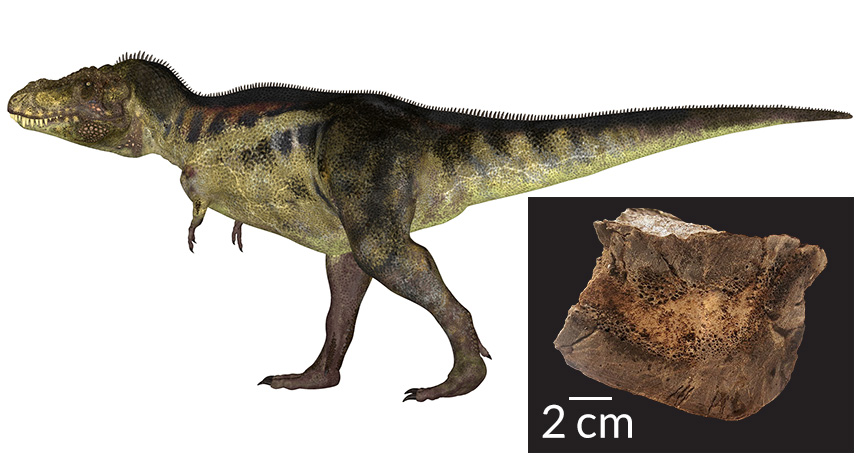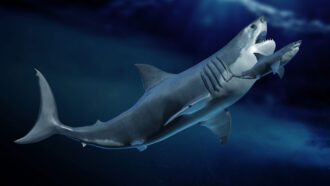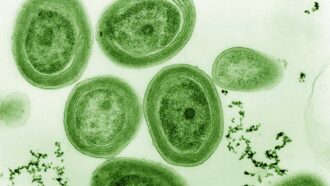How to tell if a T. rex is expecting
Dinosaur bones show temporary changes during egg-laying, just as a bird’s do

A new kind of chemical test can reveal whether a T. rex was “pregnant” — and therefore female. The test looks for loosely woven areas called “medullary” tissue inside the dino’s bones (light colored material in inset picture).
Xialmages/iStockPhoto, INSET: M. SCHWEITZER ET AL/SCIENTIFIC REPORTS 2016
By Meghan Rosen
Call it a T. rex pregnancy test. Analyzing the chemistry of tiny slivers of fossilized bone can reveal whether a Tyrannosaurus rex was about to lay eggs.
A female bird that is producing eggs is called “in lay.” And when a bird is in lay, some of her bones temporarily develop a tissue known as medullary (MED-ju-laar-ee) bone. It’s loosely woven with lots of holes, kind of like a sponge. It will fill the regular bones’ inner cavities.
Scientists had hypothesized that dinosaurs might have this tissue, too. In 2005, a team spotted what looked like medullary bone. The team was led by paleontologist Mary Schweitzer of North Carolina State University in Raleigh .A colleague had sent Schweitzer a box filled with 70-million-year-old fossil bones of a T. rex. They had been unearthed in Montana.
This dino had been about 18 years old when it died.
“I pulled the first fragment out and said, ‘Oh my gosh! It’s a girl and it’s pregnant,'” Schweitzer recalls. She had recognized the porous appearance of medullary bone. Of course, she didn’t know then, for sure, that this was what she had found.
Other bone tissue, such as broken bones that are healing, can mimic the sponge-like look of medullary bone. So Schweitzer’s team tested the T. rex tissue for keratan sulfate. It’s a chemical found in medullary bones but not other types. As suspected, this chemical was present.
Schweitzer and her colleagues published their results in the March 15 issue of Scientific Reports.
Detecting medullary bone means that scientists now can identify dinosaurs that were in lay. But to do these analyses takes destroying a little bit of fossil. Plus, there’s still no way to tell males from “non-pregnant” females. But that is the goal, Schweitzer says. Now that she knows this T. rex was a girl, she wants to examine her for other features that might prove to be tell-tale signs of her gender. These might then be used to identify other female T. rexes.
Power Words
(for more about Power Words, click here)
chemistry The field of science that deals with the composition, structure and properties of substances and how they interact with one another. Chemists use this knowledge to study unfamiliar substances, to reproduce large quantities of useful substances or to design and create new and useful substances. (about compounds) The term is used to refer to the recipe of a compound, the way it’s produced or some of its properties.
dinosaur A term that means terrible lizard. These ancient reptiles lived from about 250 million years ago to roughly 65 million years ago. All descended from egg-laying reptiles known as archosaurs. Their descendants eventually split into two lines. They are distinguished by their hips. The lizard-hipped line became saurichians, such as two-footed theropods like T. rex and the lumbering four-footed Apatosaurus. A second line of so-called bird-hipped, or ornithischian dinosaurs, led to a widely differing group of animals that included the stegosaurs and duckbilled dinosaurs.
fossil Any preserved remains or traces of ancient life. There are many different types of fossils: The bones and other body parts of dinosaurs are called “body fossils.” Things like footprints are called “trace fossils.” Even specimens of dinosaur poop are fossils. The process of forming fossils is called fossilization.
hypothesis A proposed explanation for a phenomenon. In science, a hypothesis is an idea that must be rigorously tested before it is accepted or rejected.
medullary bone A type of porous, spongy tissue that develops within the core of bones in birds that are preparing to lay eggs (and therefore female). The same tissue recently showed up in the fossil remains of a Tyrannosaurus rex.
paleontologist A scientist who specializes in studying fossils, the remains of ancient organisms.
porous The description of a substance that contains tiny holes, called pores, through which a liquid or gas can pass.
tissue Any of the distinct types of material, comprised of cells, which make up animals, plants or fungi. Cells within a tissue work as a unit to perform a particular function in living organisms. Different organs of the human body, for instance, often are made from many different types of tissues. And brain tissue will be very different from bone or heart tissue.
Tyrannosaurus rex A top-predator dinosaur that roamed Earth during the late Cretaceous period. Adults could be 12 meters (40 feet) long.







